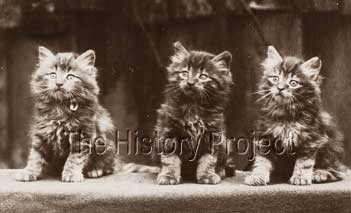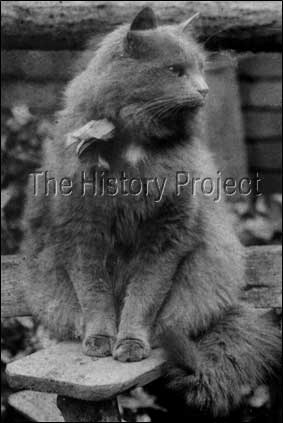 | |||||||









|
FRANCES A. SIMPSON (1857-1926)WORKING, BREEDING AND EXHIBITING:By the time Weir had penned his now famous work Our Cats and All ABout Them in 1889, a further 18 years had elapsed, and the Crystal Palace Cat Show of that year was advertised as the 21st National Cat Show. Also by this time, Frances Simpson had gone from being a wide-eyed teenager to a mature and worldly-wise 32-year-old woman, who was a cat breeder and exhibitor of considerable experience.
From her writing we know that Frances was both well-educated and erudite, and as a single woman, she would have had to find a way to sustain herself economically. She appears to have done this predominantly through her writing, including articles and commentaries in Fur and Feather and later in Our Cats, but also for other publishers, no doubt marketing herself as a rising expert on domestic felines and their many varieties. As a young judge active on the scene of cats and cat shows, this helped to give her credence. In the census of 1911, her occupation is listed as a 'journalist'. Of course, by that time, she had a number of successful publications behind her, one having been reprinted, and was regularly providing specialist discourses on breed varieties for periodicals such as Every Woman's Encyclopaedia and other educational publications. There is little doubt that she may have also written for a number of years under one or two pseudonyms, for publications such as The Ladies Field, and The Queen as well as for a growing number of American based publishers keen to obtain current cat gossip from the motherland of cat fancying.
Although we have no definitive record of when she began to take an interest in cat breeding, we do know from her own records that her first longhaired cat was a Brown Tabby: "I think it is generally known in the Fancy that I am partial to Brown Tabbies, and truly I believe they occupy the warmest corner of my cat-loving heart; perhaps, because I first started with a Brownie, or possibly because they have been a very looked-down-upon breed. However, as every dog has his day, so I hope a good time is coming for this truly handsome type of cat, so suggestive of a tiger."2 Despite this very personal penchant for 'Brownies', the greatest attention she paid to any variety was to the cause of the Blue Persian. In reminiscing about her bond with the Blues, in Cats and All About Them (1902) she asserts: "I exhibited the first pair of Blues at the Crystal Palace many years ago, and ever since we have lived and loved together!" 2 This is then reinforced in more detail, in The Book of The Cat (1903) in which she elaborates: "It is over twenty years ago that I exhibited the first 'blues' at the Crystal Palace Cat Show," (Ed: c.1881-1882) "and they created quite a sensation, for no-one seemed to have seen any cats of this peculiar shade before. Some called them grey or lilac, and others London smoke, or slate colour. One of my pair of blue kittens was quickly claimed at catalogue price, and I bought the other, fearing that I would lose her also. She in her turn became the mother of many celebrated blues.
In those early days of the fancy, blue Persians were entered in the 'any other variety' class, and most of the specimens exhibited, were in reality tabbies. For some years this state of things continued; but Mr. A.A. Clarke, so well known as one of the pioneers of the National Cat Club, and as a breeder, exhibitor, and judge, - agitated with other fanciers, myself amongst the number, to obtain a better classification for the self-coloured blues, and in 1889, the schedule at the Crystal Palace Show contained a class for 'Blue - self-coloured without white."1 Given that she had bred these first blues that had been shown twenty or more years ago, this dates her activity as a breeder from at least 1882 if not earlier. And it was probably as early as that that Frances had purchased 'Betsey', from Mrs. Ackland. 'Betsey' was bred to 'Lewis' (also owned by Mrs. Ackland), to produce 'Mater' who was a Blue Persian female, bred by Simpson, born in 1885. This makes 'Mater' (NCC: 1094) the earliest born Blue Persian to be recorded within the register of the National Cat Club.4
And the first Blue Persian to appear in the register of the National Cat Club, born on 18th September 1889, is another of Frances Simpson's breeding females, 'Bluette', (NCC: 1003) bred by Miss Jevons. Bluette has the added distinction of being among the first 3 cats in the Register!4
<< Back | 1 | 2 | 3 | 4 | 5 | 6 | 7 | 8 | 9 | 10 | Next >>
|
||||||
Home | Cats | Gallery | Clubs | People | Artifacts | Articles | Updates | Contact Us ©The CFA Foundation, Inc and The Harrison Weir Collection
|
|||||||

